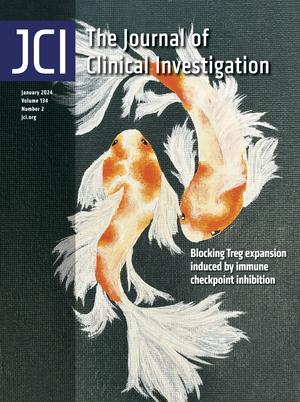Revealing hyperactivated IFN-γ pathways in perianal fistulizing Crohn's disease using single-cell and spatial multi-omics.
IF 13.6
1区 医学
Q1 MEDICINE, RESEARCH & EXPERIMENTAL
Journal of Clinical Investigation
Pub Date : 2025-07-03
eCollection Date: 2025-09-02
DOI:10.1172/JCI193413
引用次数: 0
Abstract
Up to 40% patients with Crohn's disease suffer from perianal disease, a debilitating complication with unclear etiology. This study identified unique pathophysiology which may help develop novel therapies.
通过单细胞和空间多组学研究高激活干扰素- γ通路在肛周瘘管性克罗恩病中的作用。
肛周瘘管性克罗恩病(PCD)是一种常见且衰弱的并发症,其病理生理机制难以捉摸。为了确定PCD中可操作的免疫靶点,我们招募了PCD患者(n = 24),无肛周疾病的CD患者(NPCD, n = 10)和特发性/隐腺性肛周瘘患者(IPF, n = 29)。采用单细胞rna测序(scRNA-seq)、细胞计数(CyTOF)和空间转录组学(ST)对瘘道、瘘口和直肠粘膜活检进行分析。IFN-g通路的整体过度激活将PCD与特发性肛周瘘管和无肛周瘘管束和/或肠粘膜疾病的CD区分开来。IFN-g和TNF-a信号直接诱导参与PCD直肠上皮细胞上皮到间质转化的基因。PCD中IFN-g信号的增强是由致病性Th17 (pTh17)细胞驱动的,这些细胞被过表达LPS信号(LPS_myeloid)的髓细胞募集和激活。pTh17和lps_髓样细胞共同定位于ST上PCD瘘管束附近,并驱动局部IFN-g信号传导。抗tnf通过下调T细胞和髓细胞信号促进瘘愈合,同时促进粘膜屏障修复和免疫调节过程。通过独立CD队列的大量RNA-seq数据验证了关键单细胞发现。总之,我们确定了ifn -g驱动的机制有助于发病机制,并强调了其阻断作为PCD的治疗策略。
本文章由计算机程序翻译,如有差异,请以英文原文为准。
求助全文
约1分钟内获得全文
求助全文
来源期刊

Journal of Clinical Investigation
医学-医学:研究与实验
CiteScore
24.50
自引率
1.30%
发文量
1034
审稿时长
2 months
期刊介绍:
The Journal of Clinical Investigation, established in 1924 by the ASCI, is a prestigious publication that focuses on breakthroughs in basic and clinical biomedical science, with the goal of advancing the field of medicine. With an impressive Impact Factor of 15.9 in 2022, it is recognized as one of the leading journals in the "Medicine, Research & Experimental" category of the Web of Science.
The journal attracts a diverse readership from various medical disciplines and sectors. It publishes a wide range of research articles encompassing all biomedical specialties, including Autoimmunity, Gastroenterology, Immunology, Metabolism, Nephrology, Neuroscience, Oncology, Pulmonology, Vascular Biology, and many others.
The Editorial Board consists of esteemed academic editors who possess extensive expertise in their respective fields. They are actively involved in research, ensuring the journal's high standards of publication and scientific rigor.
 求助内容:
求助内容: 应助结果提醒方式:
应助结果提醒方式:


